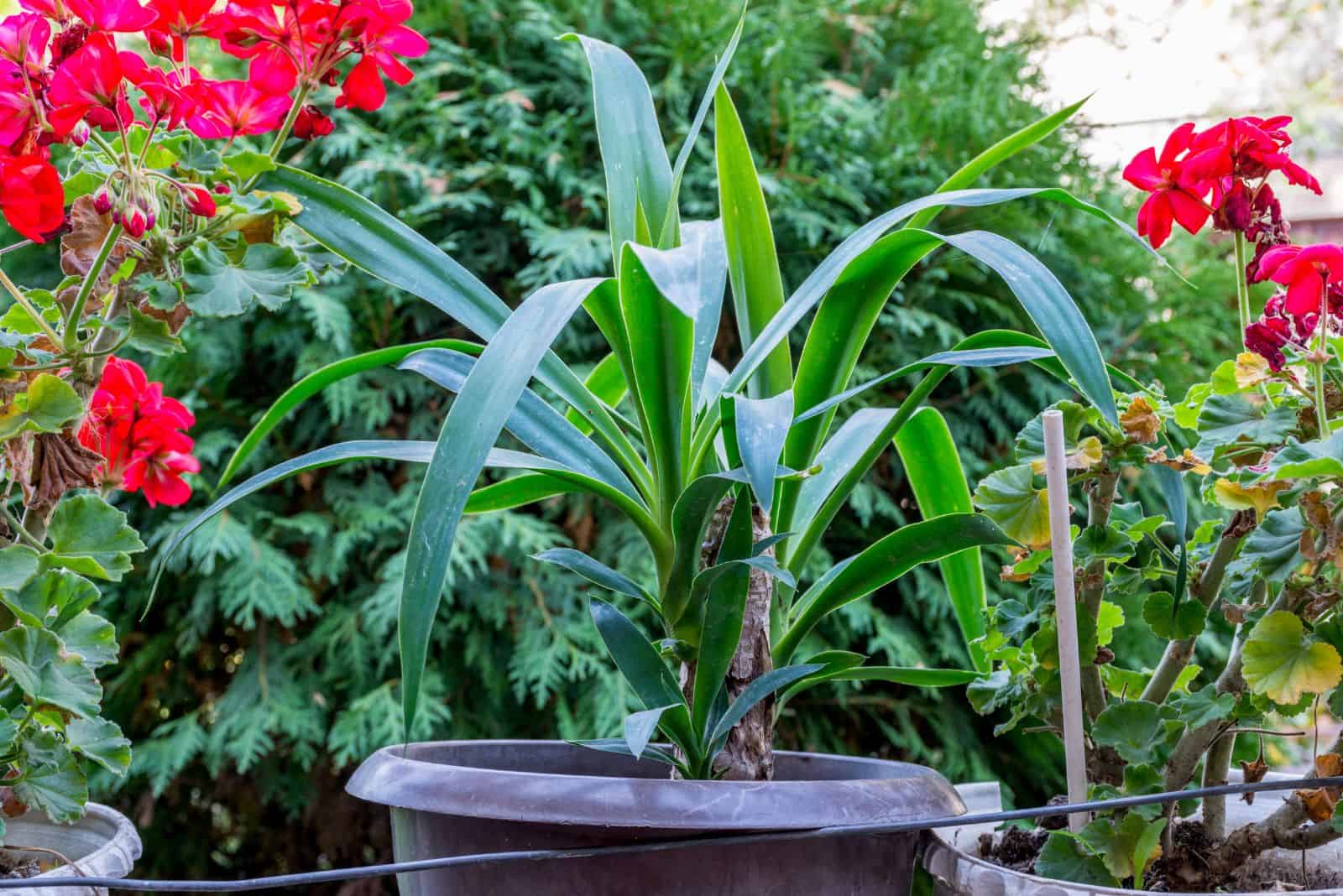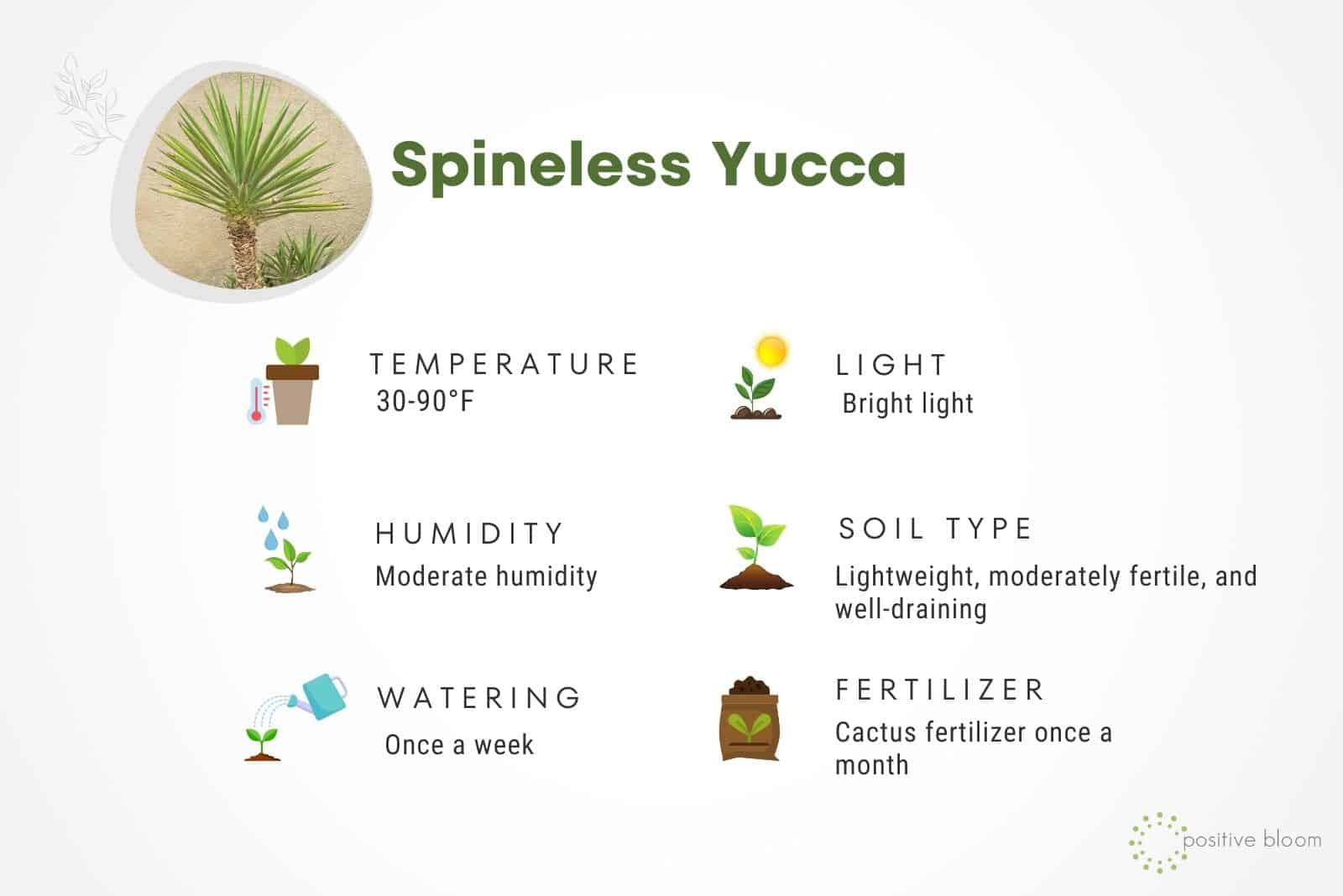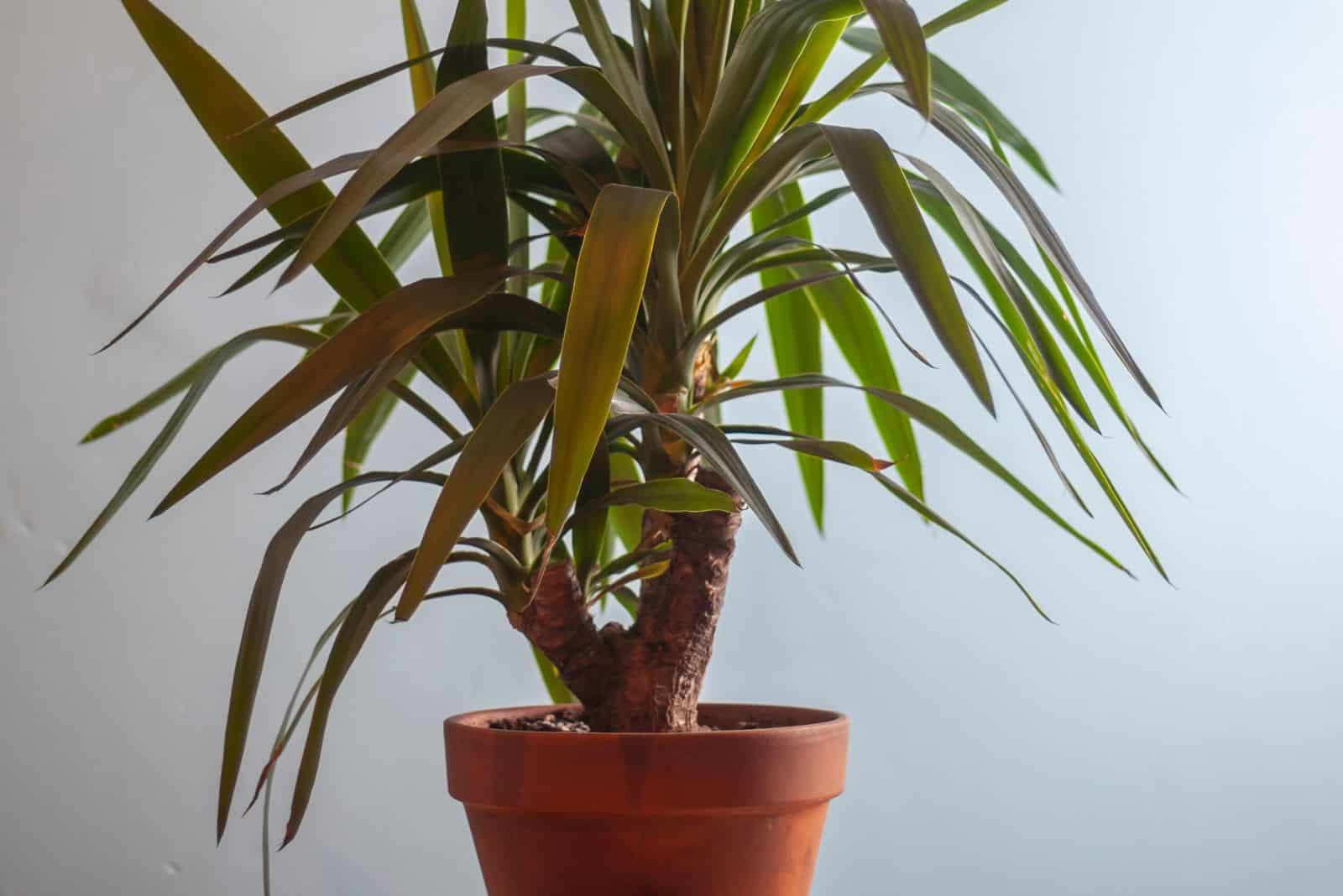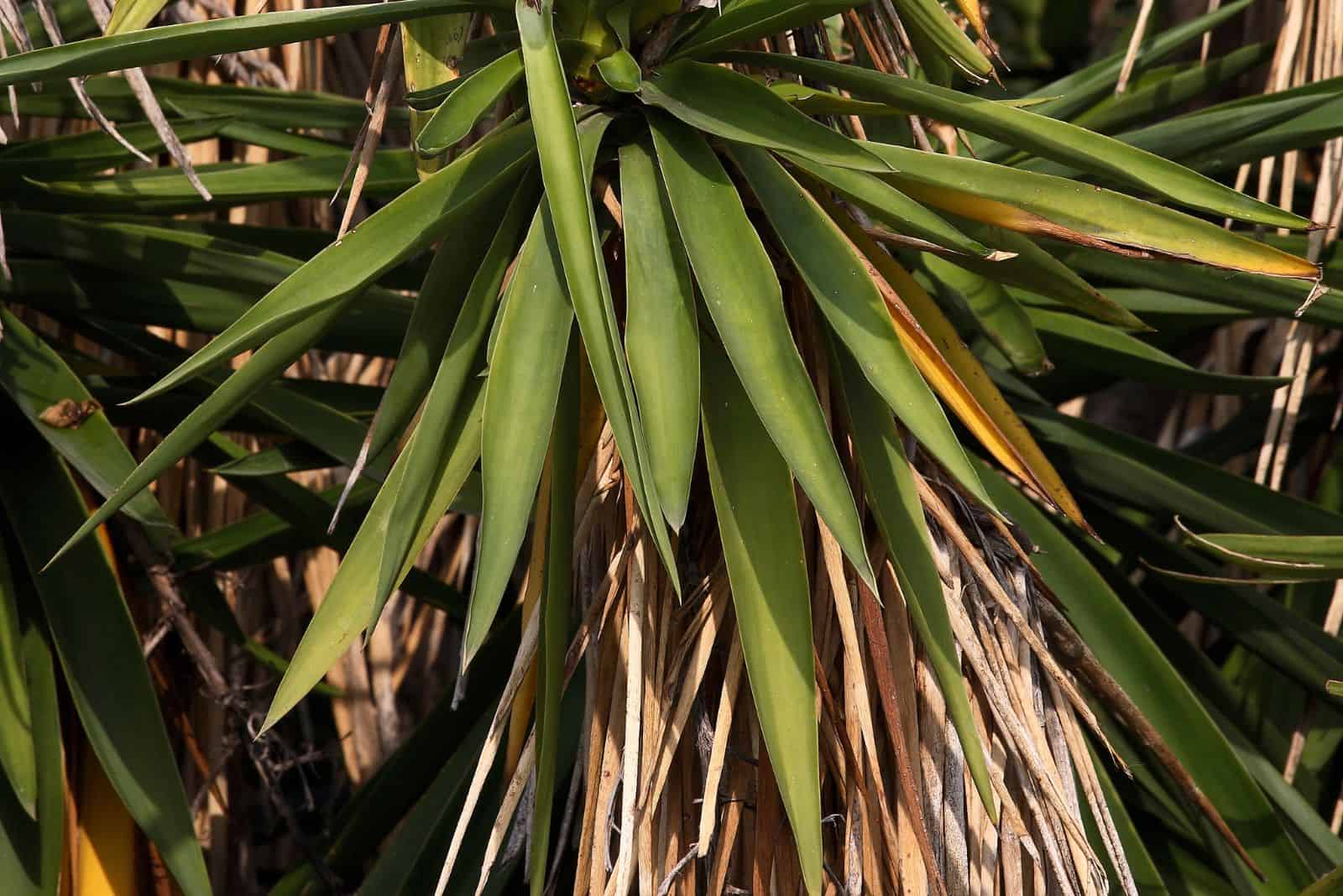Spiky plants are always a great addition to an indoor garden, and the spineless yucca is at the top of my list when it comes to this.
Its clean, pointy leaves are a beautiful green color and add so much texture to any home, and their rosette growth is all a decorator could wish for.
Plants require care to stay healthy, and that’s what I’m going to discuss in today’s article.
The spineless yucca generally requires bright light, just a bit of water, and a well-draining growing medium to look its best. That’s not all, as fertilizing, repotting, and pruning are also important components of its care.
And even if you take care of all these things, some issues can still occur, so I’ll include a tip or two to help you deal with the situation.
As for now, let’s look into its basic info:
How To Care For The Spineless Yucca
The main yucca care requirements gardeners need to meet are direct sunlight, watering it from time to time, planting in a well-draining soil, and exposing it to warm temperatures.
Of course, this isn’t everything this plant needs, and we’ll also explore its other needs, such as fertilization, repotting, and pruning.
Light Requirements
Unlike most plants that need indirect sunlight, this plant actually thrives in direct light. However, if you live in a particularly hot climate, it would be a great idea to provide it with some shade in the early afternoon.
I keep mine near a southern window, where it thrives, but you can also place it in an eastern corner of your home.
You’ll find this plant on the list of low light indoor trees as it can survive these levels, although its growth rate will be slower.
Bear in mind that if you expose it to too much shade, it can grow leggy and lose its deep green color.
Water And Humidity
This succulent shrub doesn’t require that much moisture, although it depends on the season and its growing conditions.
For instance, during its active growth period and the warmer months, you’ll need to water it once a week or even more if you live in an arid climate.
During the colder months, I reduce irrigation since temperatures aren’t that hot and there’s less evaporation. When it comes to this plant, you could get by watering it every other week or even less frequently.
The spineless yucca is susceptible to overwatering, so the best thing you can do is check the soil moisture before watering it to make sure the growing medium is dry.
And last, but not least, be aware of the type of water you use. Distilled and rainwater are perfectly fine since they don’t contain chlorine and fluoride, which can build up in your plant.
However, tap water can have this issue, so make sure to let it sit for at least a day before using it so that the chlorine evaporates. If your water has high fluoride content, you’ll have to get a filter if you want to use it for your plants.
Humidity
This plant has adapted to dry conditions, and the great news is that you don’t have to do anything regarding its humidity preferences.
It thrives in moderate humidity levels of up to 55%. However, you won’t have to mist its foliage or get a humidifier as it can thrive in lower air moisture levels.
Temperature
One of the things I love about the giant yucca is the fact that it can survive in a wide range of temperatures (from 30 to 90 degrees Fahrenheit). Conditions between 50-70 degrees are ideal, though!
Therefore, you don’t have to worry about leaving it outdoors all year long if you live in a mild climate.
However, if your region gets freezing temperatures, you should take your yucca indoors over winter. Place it in a bright, but not particularly warm location so that it can survive without waking up from dormancy.
A friend of mine said that a garage with plenty of light is her favorite overwinter plant shelter!
Soil And Fertilizer
This yucca requires moderately fertile, well-draining, and lightweight soil to thrive. Therefore, you can plant it in a regular cactus mix, which has plenty of well-draining materials.
You can also use compost for planting this shrub, but you should amend it with sand or pebbles.
Additionally, perlite and pumice have their differences, and you can use them separately or together to improve drainage.
I used to grow this plant in a regular potting mix, but no matter how rarely I watered it, it still managed to get root rot. Learn from my mistakes, and plant it in a fast-draining soil to keep it healthy.
Fertilizer
Since yuccas thrive in poorer soils, you don’t have to fertilize them at all unless you notice them struggling.
Use cactus plant food once a month during its growing season, water the plant thoroughly after fertilization, and it’ll regain its former glory.
Repotting
This yucca doesn’t mind being rootbound, but you’ll know it’s time to move it to a larger container once you can see its roots coming out through the drainage holes.
The plant may also lean as it’s too heavy, so watch for these signs and repot it when you see them.
When repotting, divide the plant’s roots if they’re too entangled. You can also prune them a bit to help your plant grow.
The next step is to choose a container large enough to hold its entire root system, and place some cactus soil mix in it.
Then put your yucca in the planter and fill the pot with more soil. Water your plant thoroughly after repotting, but if the roots are moist, give them a day or two to dry out!
If you need more helpful info for repotting a Y. gigantea, you can find them in this video:
Pruning
Pruning yucca plants isn’t necessary, but it helps them stay healthy all year long.
Monitor your plant and remove any discolored growth since these leaves are old, sunburnt, or have some kind of disease and won’t regain their color back.
You can also prune the bottommost foliage to give your plant an appearance of upward growth. This isn’t necessary, but I just love the way the plant looks after it so I removed the “skirt” (the downward facing leaves).
Finally, this plant will also produce a flower stalk filled with clusters of white blossoms. Honestly, I love those flowers, so I always let them wither on their own and prune the stalks then.
However, if you don’t care about the blossoms, or you want your plant to direct more energy into foliar growth, you can always remove the flower stalk as soon as it appears.
Propagation
The two best ways of propagating the Yucca gigantea are through stem cuttings or by using offsets.
The stem cutting method refers to cutting the entire stem and leaving the mother plant without any foliage. Using offsets, on the other hand, means you’ll just take a smaller portion of the plant and multiply that instead.
Step 1. Use a sharp knife or saw to cut the top part of the yucca stem about 4 inches below the leaves. You can also take a smaller part (a “branch”) and propagate that instead.
Step 2. Let the wound form a callous since that increases the success rate. This can take one or more days.
Step 3. Choose a container with drainage holes, place some cactus soil mix in it, and plant the yucca cutting. Pat the soil around it down firmly so that it can support the cutting and keep it upright.
Step 4. Expose the yucca to bright light and water it regularly so that the growing medium is never fully dry.
Step 5. In about a month or so, the root system should develop and you can care for your yucca plant as you would for a mature one.
Here you can find more tips for multiplying your yucca from offsets:
Common Issues
The good news about yuccas is that they’re not that susceptible to pest infestations, although it can happen. However, they are sensitive to overwatering and can easily contract root rot, so be careful about it.
Luckily, there are ways to deal with these issues. For instance, the differences between neem oil and copper fungicide can help you decide which one to use in certain situations.
Neem oil is good for both fungal infections and pets, but it works more slowly than copper fungicide when it comes to fighting fungi.
Your yucca may also suffer from droopiness and leaf discoloration, so I’ll discuss those issues as well.
Pests
One of the first things I noticed when I got this plant was that bugs aren’t a fan of it. And even if the infestations did happen, they weren’t that extensive.
Therefore, I could remove the bugs with a cotton swab and rubbing alcohol without any issues. And when I felt extra lazy, I just sprayed some neem oil. 😅
Spider mites rarely attack this plant, but the real dangers are mealybugs and scales, so watch out for these insects.
Diseases
The most common infection that affects this yucca is root rot. This disease occurs as a result of overwatering, and the easiest thing is to avoid it happening in the first place.
The best way to do that is by only watering your plant when the top third of the soil is dry. Other things you can try are using a quick-draining potting mix, such as cactus soils, and planting it in a pot with drainage holes.
However, if you suspect this disease, look for the common signs of root rot. These include leaves turning yellow and then brown, stunted growth, a rotting smell spreading from the pot, etc.
Check the plant’s roots, remove the rotten ones, spray the rest with a broad-spectrum fungicide (optional), and repot it into fresh soil and a clean planter.
Don’t water your plant for the next couple of days since there’s enough moisture around the roots already.
Droopiness
The most common cause of a spineless yucca being droopy is overwatering.
Make sure to use a quick-draining growing medium and a container with drainage holes for this plant. If the moisture cannot drain, it will pool around the roots and lead to overwatering and possibly root rot.
But if watering isn’t the issue, droopiness could be the plant’s response to inadequate sunlight. If yucca’s don’t get enough light, they’ll become droopy, leggy, and develop yellow leaves.
Too much light, on the other hand, can also lead to droopiness, but in this case you’ll notice that the leaves are yellow-brown and crispy.
Just move your plant to a location with direct sunlight in the morning and some shade in the early afternoon, and it’ll thrive.
Leaf Discolorations
Leaf discoloration happens as a result of overwatering and inadequate lighting, and I’ll help you distinguish between the two now.
If you overwater your spineless yucca, you’ll notice yellow foliage with brownish haloes around them. In this case, reduce watering, repot the plant into a planter with drainage holes, and use a fast-draining soil mix.
A plant that doesn’t get enough sunlight will turn paler and paler until it eventually becomes yellow. If this happens, gradually move your yucca to a brighter area.
Finally, sunburnt plants will also have yellow foliage, but you’ll also notice brown tips and margins as well as a crispy leaf texture. In this instance, take your plant to a more secluded location with a bit of shade during the hottest time of the day.
Final Thoughts
This article brought you everything you need to know about caring for your spineless yucca plant.
How much light, water, and fertilizer to give it, which soil to use when planting, and what temperatures to keep them at are all vital parts of caring for this beautiful plant.
I also included some tips for dealing with its common issues, such as pest infestations, disease infections, leaf discolorations, and droopiness.
I hope it helped! 🙂
Until next time!





